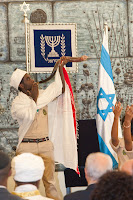 |
| Orthodox Jews Protest at Gay Pride Parade in Israel |
Being gay and an orthodox Jew – don’t mix. In the Bible, Leviticus 18:22 states: “Thou shalt not lie with mankind as with womankind, it is an abomination.” For Orthodox Jews, especially those living in Haredi communites in Israel or anywhere else in the world, this prohibition is taken very seriously.
Israel has some of the world’s most progressive gay rights legislation. (Rosenthal, 371). But when it comes down to it, more than Askenazim, Mizrahim (who tend to be more conservative and religious) still are hiding in closets, scared to come out and face rejection by their families. (Rosenthal, 372). Among the orthodox, there is absolutely no tolerance or acceptance of homosexuality. “In our world, being gay is like eating pork on Yom Kippur” says Nurit, who lives in an Orthodox religious West Bank settlement near Jerusalem (Rosenthal, 373). Many gay Orthodox Jews attempt to ignore their sexual impulses or keep them hidden. A gay man who wants to remain in the haredi community has to do more than merely keep his sexual identity hidden; he will often marry. ( Rosenthal, 378). In the Orthodox community, the number of gay men marrying in pursuit of traditional lives is much higher than in the secular world. Among gay orthodox men, some act on their impulses to a point--avoiding intercourse because of the biblical prohibition. And then there are those who lead fully gay lives, ignoring the Jewish legal ban on gay sex. This often leads to them leading a double life and secretly meeting other gay men in places far from their communities. One such place is Tel Aviv’s Independence Park, known as a meeting spot for “hit and run” homosexual encounters. Donna Rosenthal recounts the case of a haredi man at the park explaining that he was not really breaking the biblical prohibition that a “man shall not lie down with a man” because he doesn’t lie down – he does it standing up. (372)
 |
| Orthodykes symbol |
The issues for Orthodox lesbians are different than for Orthodox gay men, in part because the Torah does not specifically prohibit lesbian sex. OrthoDykes is a group for Orthodox Jewish lesbians that had its start in Israel about ten years ago. They have a very simple website in which they extend an invitation to women who are orthodox (another word they use for orthodox is “frum”) who would like to talk to other women like them. On the website myjewishlearning.com, in discussing this group and other orthodox gay underground groups, journalist Naomi Grossman talks about the fact that like men, orthodox lesbian women are often married and have children, and coming out would mean isolation for them. If you’re lesbian in the orthodox community, you keep silent and go along with the program. Growing up religious means the women are raised to be wives and taught that fulfillment means bringing children into the world. (Rosenthal, 375) Orthodoxy is all they know - they love the rituals, the Sabbath and the praying, but then religion becomes the thing that means they have to reject another important part of themselves. The underlying message of Orthodykes is that the spiritual side of a person is as powerful as the sexual side and that one can’t be ignored at the expense of the other.
 |
| JOH provides counseling and support for LGBT people from all walks of life |
There are a growing number of organizations to support LGBT people who would like to reconcile their sexual orientation with their desire to remain observant Jews. In recent years, support groups, community centers, chat rooms and websites have enabled people to safely meet and talk about topics that would normally be viewed as taboo. In Jerusalem, one of these support systems is the Jerusalem Open House. When the JOH was founded in 1997, many were incredulous as to whether LGBT people even existed in Jerusalem, let alone whether it could sustain a vibrant LGBT center. It is a community center for LGBT people from all walks of life – and the fact that it is thriving in Jerusalem is a testament to the fact that there is a need for counseling a support even in Jerusalem. A website called Orthogays, provides resources and answers to some of the most frequently asked questions. Is it possible to be Orthodox and gay or lesbian? What does the Torah say about homosexuality? What can I do about sex as an Orthodox gay Jew? Can I still be Orthodox if I have gay sex? Why did God make me gay? What about the mitzvah of peru urevu (procreation)? How can I contribute to the continuity of the Jewish people?
According to Shlomo Ashkinazy, a gay-rights activist and Orthodox Jew, these groups and sites are transforming orthodox communities. For a long time, he says, "people couldn't conceive that it was possible to be gay and frum (observant/orthodox), so they were leaving [Orthodoxy] in droves." Now, he says, "More and more people are staying frum--because of the support system and the role models."
My sources consisted of 4 websites. Two of them were support groups inviting membership – Orthodykes and JOH. Orthodykes’ website is very plain and in English only, seeming to indicate that it is geared to English speakers living in Israel. The JOH site is in Hebrew, English and Arabic and describes itself as an advocacy group while also seeking funds to support its efforts. The other two sites provided information and links and were written with a positive bias towards LGBT orthodox Jews.









